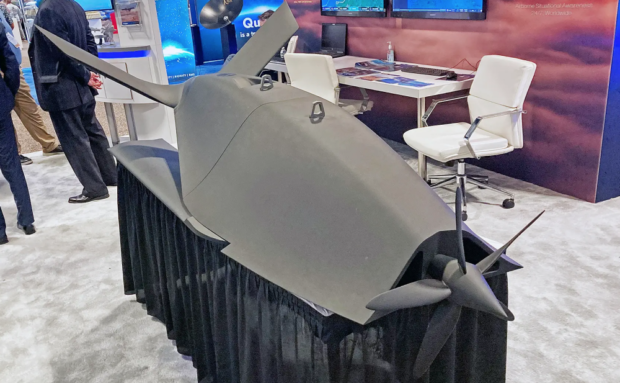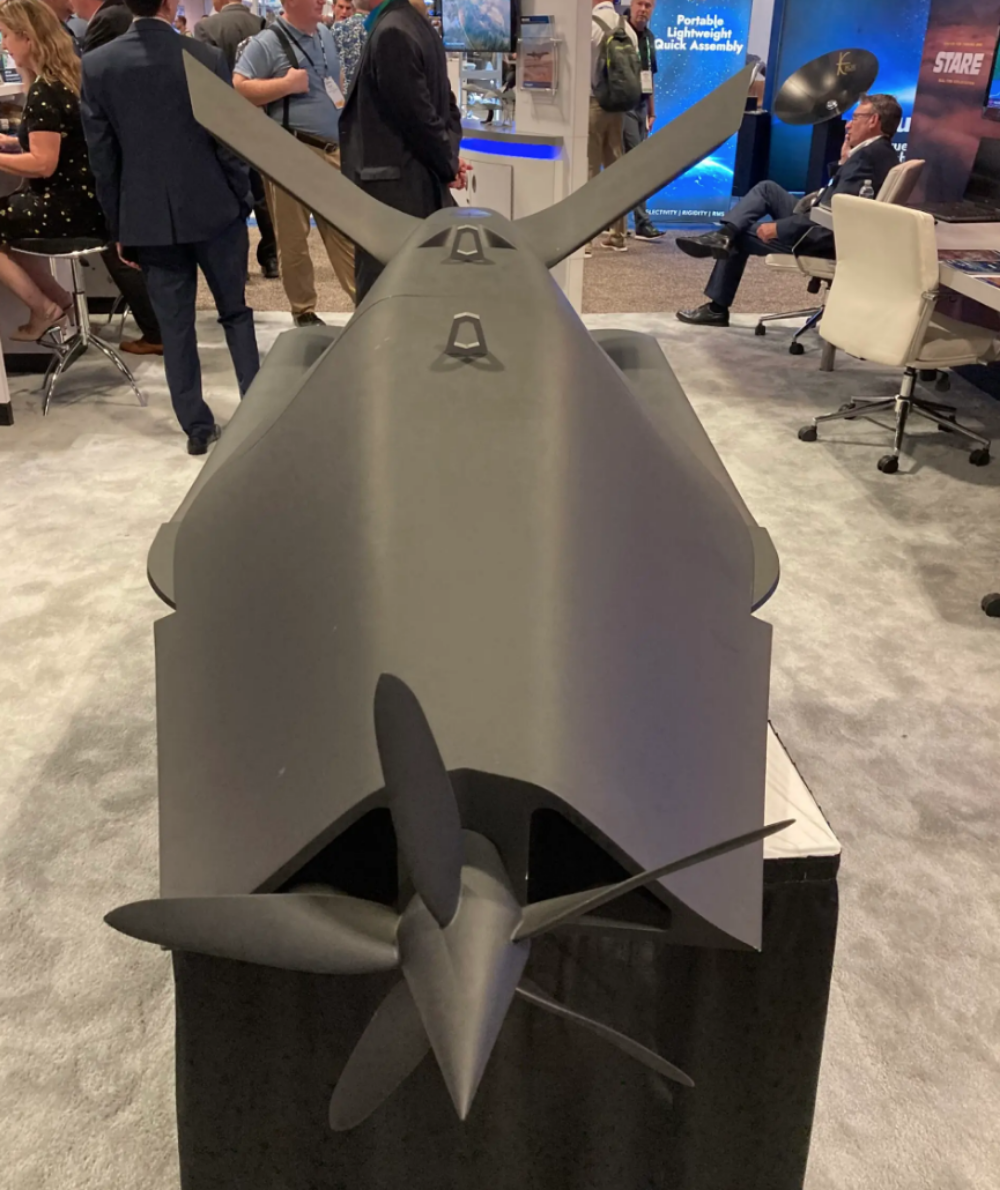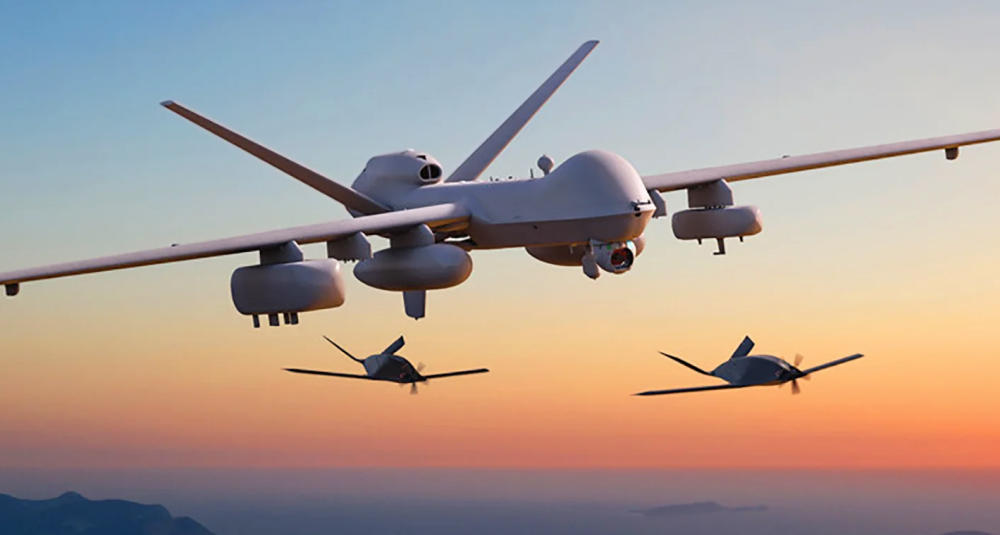General Atomic‘s new air-launched drone, dubbed ‘Eaglet,’ is set for an Army demonstration this summer.
Eaglet is designed to be launched from either the company’s MQ-1C Gray Eagle ER or MQ-9 Reaper. Though program work is still ongoing, its first flight is scheduled for later this year and General Atomics “will be demonstrating Eaglet for the U.S. Army this summer,” C. Mark Brinkley, Senior Director Strategic Communications & Marketing for General Atomics, Aeronautical Systems, or GA-ASI, told The War Zone.
Brinkley also exclusively told The War Zone the name and specification details about the new drone, developed by General Atomics to keep its legacy unmanned aerial assets relevant in modern, contested airspace.
The vehicle – which General Atomics first disclosed the existence of last year – was on display in full-sized mockup form at the 2022 Special Operations Forces Industry Conference in Tampa, which began on Monday and wrapped up today.
The propeller-driven Eaglet weighs less than 200 pounds, has a span of 10.5 feet with its pop-out wings deployed, and can fly at a maximum airspeed of 115 knots with a range of about 700 kilometers (435 miles) or about eight hours with a payload of about 20 to 30 pounds. Its maximum service ceiling is about 15,000 feet.
The mock-up shows the same general layout as had been seen in artwork and smaller models that General Atomics has displayed in the past. It is now even more apparent that the design has at least some low observable (stealthy) features, with what appears to be a flush exhaust port on the top rear portion of the drone’s body. What may be two air intakes are seen at the front on either side of the propeller shaft. A stealthy chined fuselage with sloped sides and v-tail round out the reduced signature design.
Eaglet is one of the newest entries in General Atomics’ Evolution Series of advanced UAS concepts, said Brinkley
The goal of Eaglet is to be able to allow the company’s now-vulnerable legacy drone fleet to continue providing reconnaissance and strike capabilities at a safe distance from enemy anti-access/area denial systems.
“It’s a survivable, air-launched effect (ALE) designed for use with the MQ-1C Gray Eagle ER or MQ-9 Reaper,” said Brinkley. “Eaglet provides capability for multispectral sensing and survivability on the future battlefield.”
For the better part of the past 20 years, America’s drone fleet has ruled the skies, raining down death and destruction, and soaking up intelligence largely unmolested because they were operating in permissible environments against adversaries with no air defenses or electronic warfare systems. But those days are over and the U.S. military and defense contractors have been seeking new ways to continue to provide those capabilities while leveraging existing systems. U.S. drones have been vulnerable for a while, even to non-state actors.
The inevitability of such vulnerability is why the Army launched its ALE program two years ago. Its goal is to develop a family of smaller drones that can be launched from larger manned or unmanned aircraft that are able to work together in networked swarms.
“Army Futures Command (AFC) has identified a future fight in an Integrated Air Defense Systems (IADS)-rich environment where platforms must be survivable, attritable, or expendable to deliver sensing capabilities effectively where 1) The MQ-1C Gray Eagle flies racetrack patterns tangential to the IADS threat, at 80 km [~50 miles] distance, 2a) ALEs deploy from the MQ-1C Gray Eagle as the forward most element of the advanced team in areas of expected enemy contact in order to detect, identity, locate and report (DILR) and attack/disrupt/decoy threat assets to initiate disintegration of the IADS,” according to an official 2020 Army contracting notice.
The Army wants that capability to provide ISR, electronic attack, and even lethal strikes. All while remaining “outside the range of enemy sensors and weapon systems,” according to the Army, which wants them to be survivable, but small and cheap enough to be expendable if needed.
ALE drones should also be designed to allow rapid integration of new technologies.
You can read more about the ALE effort here.
Brinkley told The War Zone that Eaglet can meet those criteria.
“Imagine a Gray Eagle ER carrying four Eaglets is flying an ISR mission near hostilities,” he postulated. “The UAS can launch its Eaglets forward into hostile airspace, where this ALE quartet can work in four-part harmony to extend the sensing envelope of the host UAS, provide electronic or kinetic warfare options, or simply disrupt an adversary’s mission planning.”
The Eaglet, he added, is
“affordable and recoverable,” allowing it to be used for multiple missions. “We don’t have pricing to announce yet, but the whole point is to balance affordability with performance,” he said. “We anticipate Eaglet’s price point to fit within the budget of expendable or attritable options. Eaglet will give commanders a variety of options when examining mission needs and risk, while holding the larger UAS at a safe standoff distance.”
GA-ASI is working on several Artificial Intelligence/Machine Learning advancements “to help UAS pilots manage and control Eaglet during missions,” Brinkley said. “These ALEs could be launched one at a time, or all at once, depending on the need.”
Eaglet is one of several ALE systems the Army is taking a look at.
The Army has previously experimented with a small drone called the Area-I small Agile-Launch Tactically Integrated Unmanned System drone, or ALTIUS. That system has already been launched from Army Gray Eagle as well as an Air Force XQ-58A Valkyrie stealthy unmanned aircraft.
Even if the Army doesn’t agree to purchase Eaglet, it is the kind of drone that, if it does what the company claims, could be attractive to the U.S. Marine Corps, which has its own Reaper that faces similar challenges in the new world of contested airspace. The USAF is also likely interested in squeezing more relevancy out of its large MQ-9 fleet, especially as work to transition to a more survivable type could drag on. Using Eaglet on ship-deployed MQ-9 conversions is another possible option as is selling them to other nations operating Reaper variants. (The U.S. is the only nation operating the Gray Eagle).
The MQ-9A Reaper is operated by U.S., UK, Italy, France, Spain and the Netherlands, said Brinkley. The customer list for the MQ-9B SkyGuardian and SeaGuardian continues to grow, with UK, Belgium, and Japan awaiting delivery, and many other nations in various stages of request and approval. The Eaglet can fit on both of those variants, Brinkley said.
For a number of years now, the future of using large, unstealthy, slow drones for many combat applications has become questionable. General Atomics is betting that Eaglet can help keep them in the fight.
Top and Middle Photos: Howard Altman



